Fish and fishery products represent a valuable source of nutrients of fundamental
importance for diversified and healthy diets. With a few exceptions for selected
species, fish is usually low in saturated fats, carbohydrates and cholesterol. Fish
provides not only high-value protein, but also a wide range of essential micronutrients,
including various vitamins (D, A and B), minerals (including calcium, iodine, zinc, iron
and selenium) and polyunsaturated omega-3 fatty acids (docosahexaenoic acid and
eicosapentaenoic acid). While average per capita fish consumption may be low, even
small quantities of fish can have a significant positive nutritional impact by providing
essential amino acids, fats and micronutrients that are scarce in vegetable-based diets.
There is evidence of beneficial effects of fish consumption in relation to coronary
heart disease, stroke, age-related macular degeneration and mental health. There is
also convincing evidence of benefits in terms of growth and development, in particular
for women and children during gestation and infancy for optimal brain development
of children.
On average, fish provides only about 33 calories per capita per day. However, it can
exceed 150 calories per capita per day in countries where there is a lack of alternative
protein food and where a preference for fish has been developed and maintained
(e.g. Iceland, Japan and several small island States). The dietary contribution of fish
is more significant in terms of animal proteins, as a portion of 150 g of fish provides
about 5060 percent of the daily protein requirements for an adult. Fish proteins
can represent a crucial component in some densely populated countries where total
protein intake levels may be low. In fact, many populations, more those in developing
countries than developed ones, depend on fish as part of their daily diet. For them, fish
and fishery products often represent an affordable source of animal protein that may
not only be cheaper than other animal protein sources, but preferred and part of local
and traditional recipes. For example, fish contributes to, or exceeds, 50 percent of total
animal protein intake in some small island developing States, as well as in Bangladesh, Cambodia, Ghana, the Gambia, Indonesia, Sierra Leone and Sri Lanka. In 2009, fish
accounted for 16.6 percent of the global populations intake of animal protein and
6.5 percent of all protein consumed (Figure 32). Globally, fish provides about 3.0 billion
people with almost 20 percent of their average per capita intake of animal protein, and
4.3 billion people with about 15 percent of such protein (Figure 33).
Total Protein Supply by Continent and Major Food Group (Average 20072009)
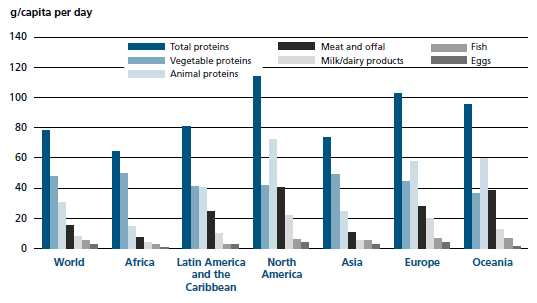
Contribution of Fish to Animal Protein Supply (Average 20072009)
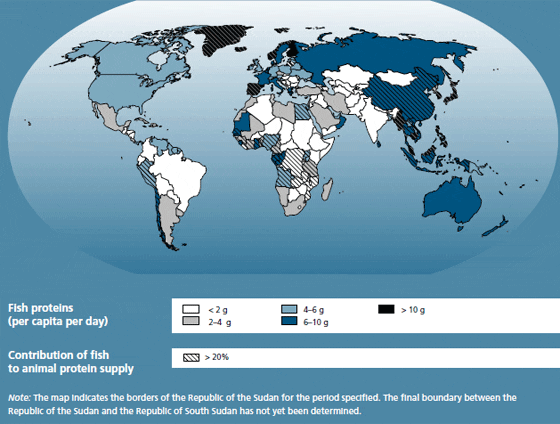
Fish as Food: Per Capita Supply (Average 20072009)
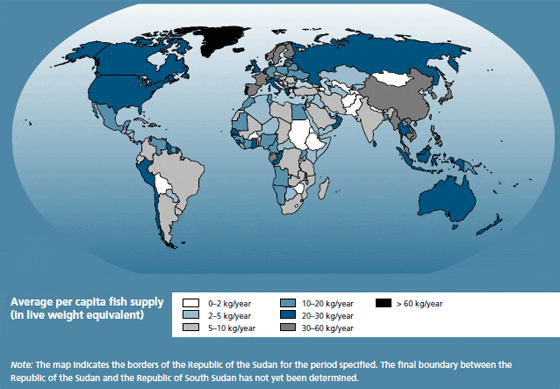
Linked to the strong expansion of fish production and of modern distribution
channels, world fish food supply grew at an average rate of 3.2 percent per year in
the period 19612009, outpacing the increase of 1.7 percent per year in the worlds
population; hence, average per capita availability has risen. World per capita fish
consumption increased from an average of 9.9 kg in the 1960s to 11.5 kg in the 1970s,
12.6 kg in the 1980s, 14.4 kg in the 1990s, 17.0 kg in the 2000s and reached 18.4 kg in
2009. Preliminary estimates for 2010 point towards a further increase in per capita fish
consumption to 18.6 kg. It should be noted that figures for 2000 are higher than those
reported in previous editions of The State of World Fisheries and Aquaculture, as FAO
has revised downwards the non-food estimates for Chinas apparent consumption,
starting from 2000 data, to reflect improved national information on the sector. As a
consequence, per capita fish consumption figures for China as well as for the world
have increased in comparison with previous assessments.
Notwithstanding the strong increase in the availability of fish to most consumers,
the growth in fish consumption differs considerably among countries and within
countries and regions in terms of quantity and variety consumed per head. For
example, per capita fish consumption has remained static or decreased in some
countries in sub-Saharan Africa (e.g. the Congo, South Africa, Gabon, Malawi and
Liberia) and in Japan in the last two decades, while the most substantial increases in
annual per capita fish consumption have occurred in East Asia (from 10.6 kg in 1961
to 34.5 kg in 2009), Southeast Asia (from 12.8 kg in 1961 to 32.0 kg in 2009) and
North Africa (from 2.8 kg in 1961 to 10.6 kg in 2009). China has been responsible for
most of the increase in world per capita fish consumption, owing to the substantial
increase in its fish production, in particular from aquaculture. Chinas share in world
fish production grew from 7 percent in 1961 to 34 percent in 2009. Per capita fish
consumption in China has also increased dramatically, reaching about 31.9 kg in 2009,
with an average annual growth rate of 4.3 percent in the period 19612009 and of
6.0 percent in the period 19902009. In the last few years, fuelled by growing domestic
income and wealth, consumers in China have experienced a diversification of the types of fish available owing to a diversion of some fishery exports towards the domestic
market as well as an increase in fishery imports. If China is excluded, annual per capita
fish supply to the rest of the world was about 15.4 kg in 2009, higher than the average
values of the 1960s (11.5 kg), 1970s (13.5 kg), 1980s (14.1 kg) and 1990s (13.5 kg). It
should be noted that during the 1990s, world per capita fish supply, excluding China,
was relatively stable at 13.113.5 kg and lower than in the 1980s as population grew
more rapidly than food fish supply (at annual rates of 1.6 and 0.9 percent, respectively).
Since the early 2000s, there has been an inversion of this trend, with food fish supply
growth outpacing population growth (at annual rates of 2.6 percent and 1.6 percent,
respectively).
Total and Per Capita Food Fish Supply by Continent and Economic Grouping in 2009
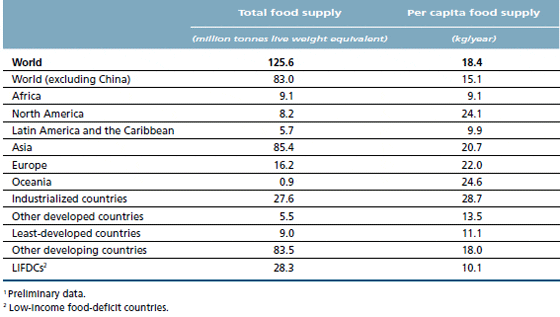
Table 13 summarizes per capita fish consumption by continent and major
economic group. The total amount of fish consumed and the species composition of
the food fish supply vary according to regions and countries, reflecting the different
levels of availability of fish and other foods, including the accessibility of fishery
resources in adjacent waters as well as the interaction of several socio-economic and
cultural factors. These factors include food traditions, tastes, demand, income levels,
seasons, prices, health infrastructure and communication facilities. Annual per capita
apparent fish consumption can vary from less than 1 kg in one country to more than
100 kg in another (Figure 34). Differences may also be significant within countries,
with consumption usually higher in coastal, riverine and inland water areas. Of the
126 million tonnes available for human consumption in 2009, fish consumption was
lowest in Africa (9.1 million tonnes, with 9.1 kg per capita), while Asia accounted
for two-thirds of total consumption, with 85.4 million tonnes (20.7 kg per capita),
of which 42.8 million tonnes was consumed outside China (15.4 kg per capita). The
corresponding per capita fish consumption figures for Oceania, North America, Europe,
and Latin America and the Caribbean were 24.6 kg, 24.1 kg, 22.0 kg and 9.9 kg,
respectively.
Differences in fish consumption exist between the more-developed and the lessdeveloped
countries. Although annual per capita consumption of fishery products has
grown steadily in developing regions (from 5.2 kg in 1961 to 17.0 kg in 2009) and in
LIFDCs (from 4.9 kg in 1961 to 10.1 kg in 2009), it is still considerably lower than that of
more developed regions, even though the gap is narrowing. The actual values may be
higher than indicated by official statistics in view of the under-recorded contribution
of subsistence fisheries and some small-scale fisheries. In 2009, apparent per capita
fish consumption in industrialized countries was 28.7 kg, while for all developed
countries it was estimated at 24.2 kg. A sizeable share of fish consumed in developed
countries consists of imports, and owing to steady demand and declining domestic
fishery production (down 10 percent in the period 20002010), their dependence on
imports, in particular from developing countries, is projected to grow. In developing
countries, fish consumption tends to be based on locally and seasonally available
products, and the fish chain is driven by supply rather than demand. However, in
emerging economies, imports of fishery products not available locally have recently
been growing.
Disparities among developed and developing countries exist also with reference
to the contribution of fish to animal protein intake. Despite their relatively low levels
of fish consumption, this share was significant at about 19.2 percent for developing
countries and 24.0 percent for LIFDCs. However, this share has declined slightly in
recent years owing to the growing consumption of other animal proteins. In developed
countries, the share of fish in animal protein intake, after consistent growth up to
1989, declined from 13.9 percent in 1984 to 12.4 percent in 2009, while consumption of
other animal proteins continued to increase.
The seafood sector remains very fragmented, in particular for markets of
fresh seafood, but it is in a phase of consolidation and globalization. Fish is very
heterogeneous and differences may be based on species, production area, method
of fishing or farming, handling practice and hygiene. Raw fish can be processed into an even wider range of products to meet consumer demands that differ according to
markets, flexibility in supply volumes, physical proximity, suppliers trustworthiness,
ability to adapt to different portion-size specifications, etc. In the last two decades,
the consumption of fish and fishery products has also been influenced considerably
by globalization in food systems and by innovations and improvements in processing,
transportation, distribution, marketing and food science and technology. These factors
have led to significant enhancements in efficiency, lower costs, wider choice and safer
and improved products. Owing to the perishability of fish, developments in longdistance
refrigerated transport and large-scale and faster shipments have facilitated
the trade and consumption of an expanded variety of species and product forms,
including live and fresh fish. Consumers can benefit from increased choice, with imports
boosting the availability of fish and fishery products in the domestic markets.
Growing interest from local consumers has also underpinned aquaculture
development in many regions in Asia and, increasingly, in Africa and in Latin
America. Since the mid-1980s, and in particular in the last decade, the contribution
of aquaculture to fish consumption has shown dramatic growth, as capture fisheries
production has stagnated or even declined in some countries. In 2010, aquaculture
contributed about 47 percent of the fishery output for human consumption
impressive growth compared with its 5 percent in 1960, 9 percent in 1980 and
34 percent in 2000 (Figure 35), with an average annual growth rate of 4.7 percent
in the period 19902010. However, if China is excluded, the average contribution
of aquaculture is significantly lower at 17 percent in 2000 and 29 percent in 2010,
corresponding to an average annual growth rate of 5.4 percent. Aquaculture has
pushed the demand for, and consumption of, species that have shifted from being
primarily wild-caught to being primarily aquaculture-produced, with a decrease in their
prices and a strong increase in their commercialization, such as for shrimps, salmon,
bivalves, tilapia, catfish and Pangasius. Aquaculture also plays a role in food security
through the significant production of some low-value freshwater species, which are
mainly destined for domestic production, also through integrated farming.
The surging contribution of aquaculture can also be noted by observing fish
consumption by major groups. Owing to the increasing production of shrimps, prawns
and molluscs from aquaculture and the relative decline in their price, annual per
capita availability of crustaceans grew substantially from 0.4 kg in 1961 to 1.7 kg in
2009, and that of molluscs (including cephalopods) rose from 0.8 kg to 2.8 kg in the same period. The increasing production of salmon, trouts and selected freshwater
species has led to a significant growth in annual per capita consumption of freshwater
and diadromous species, up from 1.5 kg in 1961 to 6.0 kg in 2009. In the last few
years, no major changes have been experienced by the other broader groups. Annual
consumption of demersal and pelagic fish species has stabilized at about 3.0 kg and
3.4 kg per capita, respectively. Demersal fish continue to be among the main species
favoured by consumers in Northern Europe and in North America (8.6 kg and 7.0 kg
per capita per year, respectively, in 2009), whereas cephalopods are mainly preferred
by Mediterranean and East Asian countries. Of the 18.4 kg of fish per capita available
for consumption in 2009, about 74 percent came from finfish. Shellfish supplied
26 percent (or about 4.5 kg per capita, subdivided into 1.7 kg of crustaceans, 0.5 kg of
cephalopods and 2.3 kg of other molluscs).
Relative Contribution of Aquaculture and Capture Fisheries to Food Fish Consumption
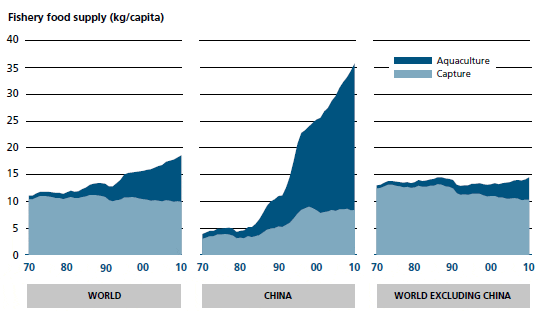
The global growth in fish consumption mirrors trends in food consumption in general.
Per capita food consumption has also been growing in the last few decades. With the
exception of the periods of the food and economic crises, the global food market,
including the fish market, has experienced unprecedented expansion and a change in
global dietary patterns, becoming more homogeneous and globalized. This change has
been the result of several factors, including rising living standards, population growth,
rapid urbanization and opportunities for trade and transformations in food distribution.
A combination of these factors has led to growing demand for proteic food products,
in particular meat, fish, milk, eggs as well as vegetables in the diet, with a reduction in
the share of staples such as roots and tubers. Protein availability has increased in both
the developed and developing world, but this growth has not been equally distributed.
There has been a remarkable increase in the consumption of animal products in countries
such as Brazil and China and in other less-developed countries. According to FAOSTAT,
annual global per capita meat consumption grew from 26.3 kg in 1967 to 32.4 kg in
1987 to reach 40.1 kg in 2007. The growth was particularly marked in the most rapidly
emerging economies of developing countries, and annual per capita meat consumption
in developing countries more than doubled from 11.2 kg in 1967 to 29.1 kg in 2007.
The supply of animal protein continues to remain significantly higher in industrialized
and other developed countries than in developing countries. However, having attained
a high level of consumption of animal protein, more developed economies have been
increasingly reaching saturation levels and are less reactive than low-income countries to
income growth and other changes. In developed countries, per capita meat consumption
increased from 61.4 kg in 1967 to 80.7 kg in 1987, but then declined to 75.1 kg in 1997
before reaching 82.9 kg in 2007.
Notwithstanding the improvement in per capita availability of food and the positive
long-term trends in nutritional standards, undernutrition (including inadequate
levels of consumption of protein-rich food of animal origin) remains a huge and
persistent problem. Malnutrition is a major problem worldwide, with one person in
seven undernourished and more than one-third of infant mortality attributable to
undernutrition. This is especially the case in many developing countries, with the bulk
of undernourished people living in rural areas. According to the FAO report The State
of Food Insecurity in the World 2011, the number of undernourished people was
850 million in 200608, of whom 223.6 million were in Africa, 567.8 million in Asia and
47 million in Latin America and the Caribbean. About two-thirds of the undernourished
originate in seven countries (Bangladesh, China, the Democratic Republic of the Congo,
Ethiopia, India, Indonesia and Pakistan) and more than 40 percent of them live in China
and India alone. According to preliminary estimates, the number of undernourished
people could have reached about 925 million people in 201011. At the same time, many
people in countries around the world, including developing countries, suffer from obesity
and diet-related diseases. This problem is caused by excessive consumption of high-fat
and processed products, as well as by inappropriate dietary and lifestyle choices.
The food sector in general is encountering a period of structural adjustment as a
result of growing incomes, modifications in the population structure, new lifestyles,
globalization, liberalization of trade and the emergence of new markets. A greater focus is also being given to marketing, with producers and retailers becoming more
attentive to consumer preferences and attempting to anticipate market expectations
in terms of quality, safety standards, variety, value addition, etc. Consumer habits have
changed significantly in the past few decades, and food issues such as indulgence,
convenience, health, ethics, variety, value for money, and safety are becoming
increasingly important, especially in more affluent economies. In these markets,
consumers are requesting higher standards in terms of food freshness, diversity,
convenience and safety, including quality assurances such as traceability, packing
requirements and processing controls. Consumers now demand guarantees that their
food has been produced, handled and sold in ways that safeguard their health, respect
the environment and address various ethical and social concerns. Health and wellbeing
are increasingly influencing consumption decisions, and fish has a particular
prominence in this respect, following mounting evidence confirming the health
benefits of eating fish (see above). This is partly related to an ageing society, but
food safety issues as well as obesity and allergic reactions have also raised awareness
about the relationship between food and health. In more-developed economies,
rapid reductions in fertility combined with improvements in survival are leading to an
ageing population, wherein an increasing proportion of the population is concentrated
among older age groups. In many countries of the more developed regions, more than
20 percent of the population are aged 60 or over. This affects the demand for different
types of food.
These ongoing changes in consumer preferences are having an increasing impact
on technological innovations and on new procedures for organizing the supply chain.
The majority of product innovations deal with incremental modifications, such as
variations in taste and packages designed for different forms of consumption. World
food markets have become more flexible, with new products entering the markets,
including value-added products that are easier for consumers to prepare. Retail
chains, transnational companies and supermarkets are also emerging as a major force,
particularly in developing countries, offering consumers a wider choice, reduced
seasonal fluctuation in availability and, often, safer food. Several developing countries,
especially in Asia and Latin America, have experienced a rapid expansion in the number
of supermarkets, which are increasingly targeting lower- and middle-income consumers
as well as the higher-income groups.
Growing urbanization is one of the factors modifying food consumption patterns,
with an impact also on the demand for fishery products. People living in urban areas
tend to devote a higher proportion of their income to food purchased and, in addition,
to eat out of the home more frequently, and to purchase larger quantities of fast and
convenience foods. Moreover, increasing urbanization compounds the pressure on
adjacent areas to meet the demand of large, concentrated populations. According
to the United Nations Population Division, in 2011 52.1 percent (3.6 billion people)
of the worlds population were living in urban areas. Disparities in the levels of
urbanization persist among countries and regions of the world, with more-developed
countries having an urban share of up to 78 percent, while others remain mostly rural,
in particular, LDCs (with an urban share of about 29 percent) and Africa (40 percent)
and Asia (45 percent). However, also in these latter areas, a vast movement of the
population towards the cities is taking place. An additional 294 million and 657 million
people are expected to become urbanized by 2015 and 2020, respectively, with the
bulk of the increase in urban areas expected in Asia and Africa. By 2050, the shares of
urban population will be 58 percent in Africa and 64 percent in Asia, although this will
still be significantly less than most other continents. The rural population is expected to
decline in every major area except in Africa.
The outlook for the global food sector remains uncertain. It is facing various
challenges related to the economic turndowns in selected countries and demographic
issues, including growing urbanization. The long-term forecast for food demand
remains positive, also driven by population growth and urbanization. In particular, demand for fish products is expected to continue to rise in the coming decades.
However, future increases in per capita fish consumption will depend on the
availability of fishery products. With capture fisheries production stagnating,
major increases in fish food production are forecast to come from aquaculture (see
p. 188). However, future demand will be determined by a complex interaction of
several factors and elements. The global food sectors, including the fishery sector,
will have to face several challenges stemming from demographic, dietary, climate
and economic changes, including reduced reliance on fossil energy and increasing
constraints on other natural resources. In particular, the future supply and demand
of food commodities, including fisheries, will be affected by population dynamics
and the location and rate of economic growth. World population growth is expected
to slow in the next decade, in all regions and continents, with developing countries
continuing to experience the most rapid population increases. The global population
is set to increase from about 7 billion in 2011 to 7.3 billion in 2015 and to 7.7 billion
in 2020 and 9.3 billion in 2050, with the bulk of the increase occurring in developing
countries, according to the medium-variant projections prepared by the United
Nations. Much of this increase is projected to come from the high-fertility countries
and it is expected to occur in urban areas (see above).
September 2012
Further ReadingYou can view the full report by clicking here. |



